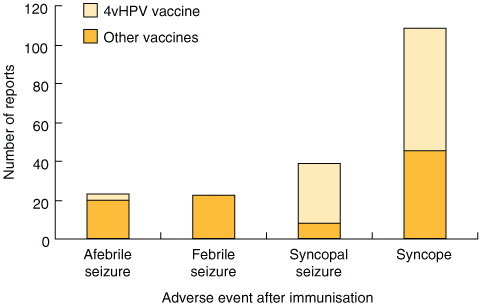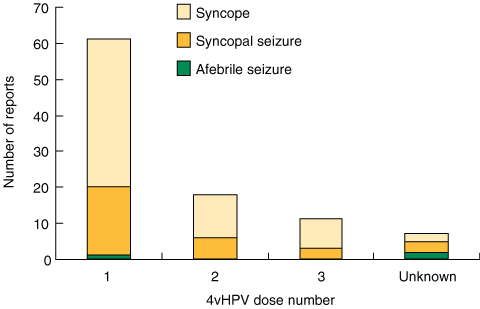The link between human papillomavirus (HPV) infection and anogenital cancers is well established.1 The quadrivalent HPV (4vHPV Gardasil [Merck/CSL]) vaccine protects against HPV (types 6, 11, 16, and 18) and is efficacious in preventing high-grade cervical lesions that could progress to cancer.2 In Australia, approximately 700 women are diagnosed with cervical cancer each year, and there were 200 deaths in 2005.3 A national HPV immunisation program was conducted between May 2007 and December 2009 for all females aged 12–26 years. The 2007 coverage rate in Victorian schools was 81% for the first dose, and 70% received all three doses.4 The ongoing program includes Year 7 girls, aged 12–13 years.
Monitoring of adverse events following immunisation (AEFI) is important. AEFI temporally associated with vaccines are not necessarily causally related, but require further investigation. Clinical trials safety data demonstrated no difference in syncope between 4vHPV and control recipients (0.1% vaccine; 0.2% placebo) in more than 21 000 participants.5 4vHPV post-licensure safety monitoring, critical for less common AEFI, has been described internationally and in Australia.6-8
A syncopal episode (vasovagal, faint) occurs due to vagal nerve stimulation with bradycardia and transient hypotension. A painful stimulus (eg, vaccination) is a well described trigger.9,10 Vaccinees appear pale and have a brief loss of or alteration in consciousness. The peak age for men and women is 15 years.11,12 A brief seizure-like event can occur with syncope, secondary to transient hypoxia, with stiffening (tonic) movements and autonomic instability (eg, urinary incontinence). An individual with epilepsy may also have a seizure temporally associated with vaccination.
The 4vHPV vaccine implementation received high media coverage, including an episode of mass psychogenic illness occurring in Melbourne within weeks of commencement of the program.13 In Valencia, Spain, two women were hospitalised after HPV vaccination, which led to temporary cessation of the local program in 2009.14
SAEFVIC is the Victorian enhanced passive AEFI surveillance system established in April 2007.15 Supplemental de-identified AEFI reports sent directly to the Therapeutic Goods Administration (TGA) were forwarded to SAEFVIC for assessment. AEFI reports are entered into a central database and clarified by an immunisation nurse with the consenting vaccinee, and/or reporter. Reports of significant AEFI are encouraged but not mandatory, and are predominantly received from immunisation nurses and general practitioners. SAEFVIC physician review appointments for children and adults are offered. Further 4vHPV vaccine doses are administered under supervision in-clinic, with patients lying supine 5 minutes before and 20 minutes after vaccination.
All AEFI reports to SAEFVIC from 1 May 2007 to 30 April 2009 were selected for analysis. AEFI with 4vHPV vaccine and coded as “syncope” or “seizure” were reviewed by a paediatrician (N W C), epidemiologist (H J C) and immunisation nurse (S E) for compliance with the Australian immunisation handbook definitions (Box 1).16
In the 2-year study period, 29% (485/1653) of SAEFVIC reports included 4vHPV vaccine. A total of 192 reports involved seizures and/or syncope. Of these, 51% (97/192) of patients had received 4vHPV vaccine (Box 2). Nine reports were from the TGA (9%). All patients were female, and the median age was 15 years (range, 8–26 years).
AEFI according to 4vHPV vaccine dose number are detailed in Box 3. The 4vHPV vaccine was given alone in 85% (82/97) of reports, with concomitant vaccines including: hepatitis B (6); diphtheria-tetanus-acellular pertussis (6); varicella (1); and varicella and hepatitis B vaccine (2). After the AEFI, 11% (11/97) were taken to hospital by ambulance. An injury occurred in seven cases, none after syncope alone: head injury (5), mouth bleeding (1) and T5/T6 vertebral fracture (1).
The Victorian reporting rate of syncope after 4vHPV vaccine of 7.8 per 100 000 doses distributed is similar to the United States Vaccine Adverse Event Reporting System (VAERS) reporting rate of 8.2 per 100 000.6 As it is a passive AEFI surveillance system, it is likely to be an under-reported rate. It is, however, higher than the nationwide rate of syncope after 4vHPV vaccine of 2.5 per 100 000 doses distributed,8 which may reflect the differing state-based AEFI reporting and clinical review systems within Australia. Syncopal episodes are not without potential morbidity and mortality, with one reported death following head injury after a syncope several minutes after immunisation.17
The reporting rate of syncopal seizures after 4vHPV vaccine found in our study was 2.6 per 100 000 doses distributed. This compares with 1.2 per 100 000 doses in the 1998 Australian measles catch-up vaccination campaign.18 That campaign, however, included young children less likely to experience syncopal episodes. The 4vHPV vaccine post-licensure reporting of syncopal seizures has led the product information to include: “syncope, sometimes accompanied by tonic–clonic movements”.19
The fact that syncope occurred after 4vHPV administration is not unexpected, as vaccination is a painful stimulus and a young female population was targeted in this catch-up program. Syncope has been reported to VAERS following the introduction of many vaccines targeted at adolescents, including quadrivalent meningococcal conjugate vaccine.20 VAERS is a passive surveillance system, with reports made online from immunisation providers and parents. Although it is not linked to a clinical service, it can lead to review of case records and further investigation of potential flags raised through passive surveillance.
The differentiation between a syncopal seizure and an afebrile seizure is important and can be difficult. Of the 68 US AEFI reports of seizures after HPV vaccination, US researchers stated: “some reports to VAERS of seizures may be anoxic seizures resulting from syncopal episodes”,6 but they were unable to delineate this further. By obtaining further information from the reporter and vaccinee, SAEFVIC was able to better distinguish syncopal and afebrile seizures. Cardiogenic syncope (eg, prolonged QT syndrome) is an important differential if the patient has a history of palpitations or exertional syncope and/or a positive family history of sudden collapse or death.12 Any flag on history or cardiac examination warrants further investigation (eg, ECG, cardiology review).
TGA de-identified reports by medical practitioners (9%) often had missing demographic data, and clinical follow-up was not possible. Immunisation providers in Victoria are now encouraged to report AEFI directly to SAEFVIC. Another limitation is determining rates of AEFI with distributed rather than administered doses. When the national HPV register is fully operational, administered dose data will be available.4
1 Adverse event following immunisation: definitions*
febrile — with fever ≥ 38.5°C;
afebrile — without fever; or
syncopal — syncope/vasovagal episode followed by seizure(s).
Received 10 March 2010, accepted 1 September 2010
- Nigel W Crawford1,2,3
- Hazel J Clothier1
- Sonja Elia4
- Teresa Lazzaro1,2,4
- Jenny Royle2,4
- Jim P Buttery1,2,5
- 1 SAEFVIC Immunisation Safety Group, Murdoch Childrens Research Institute, Melbourne, VIC.
- 2 Department of General Medicine, Royal Children’s Hospital, Melbourne, VIC.
- 3 Department of Paediatrics, University of Melbourne, Melbourne, VIC.
- 4 Immunisation Service, Royal Children’s Hospital, Melbourne, VIC.
- 5 Paediatric Infectious Diseases Unit, Monash Children’s Hospital, Melbourne, VIC.
Thanks to all the SAEFVIC staff. Nigel Crawford acknowledges support from a National Health and Medical Research Council (NHMRC) PhD Postgraduate Public Health Scholarship (437031).
Nigel Crawford has received project grant support from CSL Limited and travel support from Wyeth (Pfizer) Pharmaceuticals, and Jim Buttery has received travel support from GlaxoSmithKline. Honoraria and payment for board membership from CSL Limited (Jim Buttery) and Wyeth (Pfizer) Pharmaceuticals (Nigel Crawford) and GlaxoSmithKline speakers’ bureau (Jim Buttery) were received by the authors’ research group at the Murdoch Childrens Research Institute.
- 1. Frazer IH, Cox JT, Mayeaux EJ, et al. Advances in prevention of cervical cancer and other human papillomavirus-related diseases. Pediatr Infect Dis J 2006; 25: S65-S81.
- 2. Joura EA, Leodolter S, Hernandez-Avila M, et al. Efficacy of a quadrivalent prophylactic human papillomavirus (types 6, 11, 16, and 18) L1 virus-like-particle vaccine against high-grade vulval and vaginal lesions: a combined analysis of three randomised clinical trials. Lancet 2007; 369: 1693-1702.
- 3. Australian Institute of Health and Welfare. Cervical screening in Australia 2006–2007. Cancer series no. 47. Cat. no. CAN 43. Canberra: AIHW, 2009.
- 4. Brotherton JML, Deeks SL, Campbell-Lloyd S, et al. Interim estimates of human papillomavirus vaccination coverage in the school-based program in Australia. Commun Dis Intell 2008; 32: 457-461.
- 5. Block SL, Brown DR, Chatterjee A, et al. Clinical trial and post-licensure safety profile of a prophylactic human papillomavirus (types 6, 11, 16, and 18) L1 virus-like particle vaccine. Pediatr Infect Dis J 2010; 29: 95-101.
- 6. Slade BA, Leidel L, Vellozzi C, et al. Postlicensure safety surveillance for quadrivalent human papillomavirus recombinant vaccine. JAMA 2009; 302: 750-757.
- 7. Agorastos T, Chatzigeorgiou K, Brotherton JML, Garland SM. Safety of human papillomavirus (HPV) vaccines: a review of the international experience so far. Vaccine 2009; 27: 7270-7281.
- 8. Therapeutic Goods Administration. Human papillomavirus vaccine (GARDASIL). Advice from the TGA. Updated 5 May 2009. http://csgpn.org.au/ee/images/uploads/immunisation/tga_safety_advice_09.pdf (accessed Dec 2009).
- 9. Thijs RD, Bloem BR, van Dijk JG. Falls, faints, fits and funny turns. J Neurol 2009; 256: 155-167.
- 10. McKeon A, Vaughan C, Delanty N. Seizure versus syncope. Lancet Neurol 2006; 5: 171-180.
- 11. Ganzeboom KS, Mairuhu G, Reitsma JB, et al. Lifetime cumulative incidence of syncope in the general population: a study of 549 Dutch subjects aged 35–60 years. J Cardiovasc Electrophysiol 2006; 17: 1172-1176.
- 12. Lewis DA, Dhala A. Syncope in the pediatric patient: the cardiologist’s perspective. Pediatr Clin North Am 1999; 46: 205-219.
- 13. Buttery JP, Madin S, Crawford NW, et al. Mass psychogenic response to human papillomavirus vaccination. Med J Aust 2008; 189: 261-262. <MJA full text>
- 14. Associated Foreign Press. Spain withdraws cervical cancer shot after illnesses. 2009; 10 Feb. http://www.google.com/hostednews/afp/article/ALeqM5gIPeSOSkC3zU3Xd4HMRiovY9ri-Q (accessed Dec 2009).
- 15. Department of Health Victoria. SAEFVIC Immunisation Safety [website]. http://www.saefvic.org.au (accessed Jun 2010).
- 16. National Health and Medical Research Council. Australian immunisation handbook. 9th ed. Canberra: NHMRC, 2008. http://www.health.gov.au/internet/immunise/publishing.nsf/Content/Handbook-home (accessed Dec 2009).
- 17. Woo EJ, Ball R, Braun MM. Fatal syncope-related fall after immunization. Arch Pediatr Adolesc Med 2005; 159: 1083.
- 18. D’Souza RM, Campbell-Lloyd S, Isaacs D, et al. Adverse events following immunisation associated with the 1998 Australian Measles Control Campaign. Commun Dis Intell 2000; 24: 27-33.
- 19. Highlights of prescribing information. Gardasil. http://www.merck.com/product/usa/pi_circulars/g/gardasil/gardasil_pi.pdf (accessed Oct 2010).
- 20. Centers for Disease Control and Prevention (CDC). Syncope after vaccination — United States, January 2005 – July 2007. MMWR Morb Mortal Wkly Rep 2008; 57: 457-460.







Abstract
Objective: To quantify and characterise the reports of syncope and seizures following quadrivalent (4v) human papillomavirus (HPV) vaccination.
Design and setting: Retrospective case series of notifications to SAEFVIC (Surveillance of Adverse Events Following Vaccination In the Community), May 2007 – April 2009.
Main outcome measures: Incidence of syncope and seizure following 4vHPV vaccination; clinical outcomes.
Results: 97/1653 SAEFVIC reports met the study criteria: afebrile seizures (3), syncopal seizures (31) and syncope alone (63). Median age at vaccination was 15 years (range, 8–26 years). Injuries were reported in seven cases, including one vertebral fracture. A SAEFVIC clinic review was undertaken in 41% (40/97) and 22 patients received further 4vHPV vaccine doses administered supine, with no recurrences. The reporting rate after 4vHPV vaccine for syncope and syncopal seizures was 7.8/100 000 and 2.6/100 000 doses distributed, respectively.
Conclusion: Syncope and syncopal seizures occurred after 4vHPV vaccination in Victoria at rates similar to those seen internationally. Clinical review allowed clarification of the diagnosis and management, including safe administration of further doses under supervision.